-
-
THE ART OF HAMLET
|
Hamlet and the Ghost - by Henry Fuseli (1741-1825)
|
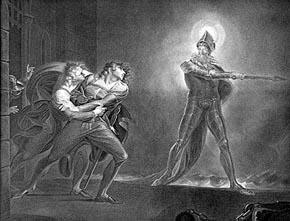 This print of Fuseli's 1789 painting depicts the scene (Act I, scene iv) in which Horatio first brings Hamlet to see the ghost of his father, the former King of Denmark, who has been haunting the gates of Elsinore. Fuseli created this dramatic image of Hamlet following his father's Ghost for Boydell's Shakespeare Gallery, which opened in London in 1789 and contained a collection of paintings from Shakespeare commissioned from the most important artists of the day. This print of Fuseli's 1789 painting depicts the scene (Act I, scene iv) in which Horatio first brings Hamlet to see the ghost of his father, the former King of Denmark, who has been haunting the gates of Elsinore. Fuseli created this dramatic image of Hamlet following his father's Ghost for Boydell's Shakespeare Gallery, which opened in London in 1789 and contained a collection of paintings from Shakespeare commissioned from the most important artists of the day. |
|
Hamlet and Ophelia - by Dante Gabriel Rossetti (1828-1882)
|
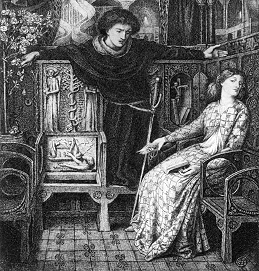 In this pen-and-ink drawing (1858), Rossetti depicts the scene (Act III, scene i) in which Ophelia attempts to return to Hamlet the "remembrances" he has given her. Critics have noted Rossetti's masterful attention to detail in this picture. On the back of the seat upon which Hamlet rests his right arm is a carving of the Tree of Knowledge guarded by two angels with swords. Vertically on either side of the Tree there is an inscription, slightly altered from Genesis 3:5, which reads "Eritis sicut deus scientes bonum et malum" or "You will be as a god, knowing both good and evil." A serpent is wound about the Tree and wears a crown, reminding us of the ghost's warning to Hamlet: "But know, thou noble youth, / The serpent that did sting thy father's life / Now wears his crown." The Tree is a remarkably appropriate symbol for Hamlet, who spends most of the tragedy obsessed with gaining knowledge of the true nature of the ghost and its accusation that Hamlet's father was murdered by Claudius. In this pen-and-ink drawing (1858), Rossetti depicts the scene (Act III, scene i) in which Ophelia attempts to return to Hamlet the "remembrances" he has given her. Critics have noted Rossetti's masterful attention to detail in this picture. On the back of the seat upon which Hamlet rests his right arm is a carving of the Tree of Knowledge guarded by two angels with swords. Vertically on either side of the Tree there is an inscription, slightly altered from Genesis 3:5, which reads "Eritis sicut deus scientes bonum et malum" or "You will be as a god, knowing both good and evil." A serpent is wound about the Tree and wears a crown, reminding us of the ghost's warning to Hamlet: "But know, thou noble youth, / The serpent that did sting thy father's life / Now wears his crown." The Tree is a remarkably appropriate symbol for Hamlet, who spends most of the tragedy obsessed with gaining knowledge of the true nature of the ghost and its accusation that Hamlet's father was murdered by Claudius. |
|
The Play-scene in Hamlet - by Daniel Maclise (1806-1870)
|
|
|
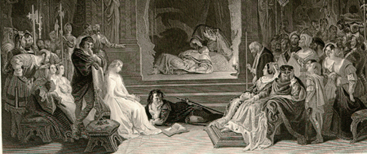 Daniel Maclise's 1842 painting The Play-scene in Hamlet depicts the scene in which Hamlet has arranged for Claudius to watch a re-enactment of the murder of Hamlet's father. William Makepeace Thackeray reviewed Maclise's painting for Ainsworth's Magazine in 1842. He described the picture as follows: Daniel Maclise's 1842 painting The Play-scene in Hamlet depicts the scene in which Hamlet has arranged for Claudius to watch a re-enactment of the murder of Hamlet's father. William Makepeace Thackeray reviewed Maclise's painting for Ainsworth's Magazine in 1842. He described the picture as follows:
Fancy Hamlet, ungartered, lying on the ground, looking into the very soul of King Claudius, who writhes under the play of Gonzago. Fancy the Queen, perplexed and sad, (she does not know of the murder,) and poor Ophelia, and Polonius, with his staff, pottering over the tragedy; and Horatio, and all sorts of knights and ladies, looking wondering on. Fancy, in the little theatre, the king asleep; a lamp in front casts a huge forked fantastic shadow over the scene--a shadow that looks like a horrible devil in the background that is grinning and aping the murder. Fancy ghastly flickering tapestries of Cain and Abel on the walls, and all this painted with the utmost force, truth, and dexterity--fancy all this, and then you will have not the least idea of the most startling, wonderful pictures that the English school has ever produced.
|
|
Ophelia - by Henrietta Rae (1859-1928)
|
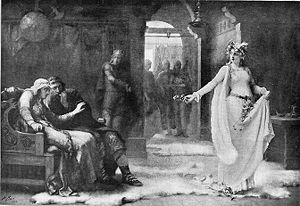 This engraving of the 1890 painting by Henrietta Rae depicts the scene (Act IV, scene v) in which Claudius and Gertrude watch Ophelia who, mad with grief, nonsensically recites the names of various herbs and flowers including rue (a bitter herb), rosemary, pansies, fennel, columbine, daisies and violets, as she scatters them about. Critics have noted the interesting composition of this painting, split almost perfectly in half between light and dark. It has been suggested that this perhaps symbolizes the chasm in Ophelia's mind caused by her grief. This engraving of the 1890 painting by Henrietta Rae depicts the scene (Act IV, scene v) in which Claudius and Gertrude watch Ophelia who, mad with grief, nonsensically recites the names of various herbs and flowers including rue (a bitter herb), rosemary, pansies, fennel, columbine, daisies and violets, as she scatters them about. Critics have noted the interesting composition of this painting, split almost perfectly in half between light and dark. It has been suggested that this perhaps symbolizes the chasm in Ophelia's mind caused by her grief. |
|
Ophelia - by Arthur Hughes (1831-1915)
|
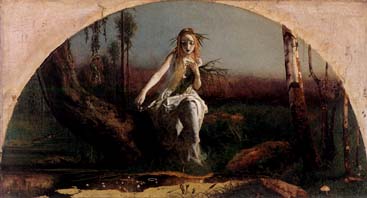 This painting by nineteen-year-old Arthur Hughes was originally exhibited at the Royal Academy in 1852. Though not the first to employ a moonlit setting for this scene, Hughes cleverly utilized the moonlight in his painting to suggest the disorder of Ophelia's psychological state. He also suggested her status as a kind of sacrificial victim by contriving to have the vegetation in her hair stick out in spikes like an improvised crown of thorns, leading some critics to describe his Ophelia as a "juxtaposition of childlike femininity and Christian martyrdom." This painting by nineteen-year-old Arthur Hughes was originally exhibited at the Royal Academy in 1852. Though not the first to employ a moonlit setting for this scene, Hughes cleverly utilized the moonlight in his painting to suggest the disorder of Ophelia's psychological state. He also suggested her status as a kind of sacrificial victim by contriving to have the vegetation in her hair stick out in spikes like an improvised crown of thorns, leading some critics to describe his Ophelia as a "juxtaposition of childlike femininity and Christian martyrdom." |
|
Ophelia - by John Everett Millais (1829-1896)
|
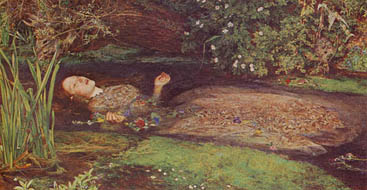 This Pre-Raphaelite painting by Sir John Everett Millais depicts the tragic death of Ophelia as she falls into the stream and drowns. Millais began working on the painting in the summer of 1851, painting the river and background by the river Ewell near Kingston-Upon-Thames. His model, Elizabeth Siddall, reportedly suffered "fleshy mortifications" as she sat for the picture. The painting was completed in London during the following winter and shown at the Royal Academy Exhibition in 1852. Although it was attacked by critics who believed the background overwhelmed Ophelia and diminished the pathos of the scene, Millais' Ophelia has become one of the best-known illustrations from Hamlet. This Pre-Raphaelite painting by Sir John Everett Millais depicts the tragic death of Ophelia as she falls into the stream and drowns. Millais began working on the painting in the summer of 1851, painting the river and background by the river Ewell near Kingston-Upon-Thames. His model, Elizabeth Siddall, reportedly suffered "fleshy mortifications" as she sat for the picture. The painting was completed in London during the following winter and shown at the Royal Academy Exhibition in 1852. Although it was attacked by critics who believed the background overwhelmed Ophelia and diminished the pathos of the scene, Millais' Ophelia has become one of the best-known illustrations from Hamlet. |
|
|